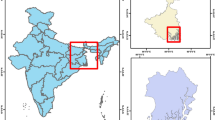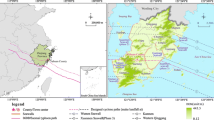Abstract
Many bays worldwide are susceptible to coastal hazards such as storm surges, river floods, and tsunamis. Because most previous studies have focused on one or two of the above-mentioned hazards, in this study, we assess coastal vulnerability based on all three hazards. To accommodate the increase in the number of cases in multihazard analysis, an efficient method based on an estimated overflow volume without computing for inundation is proposed. Subsequently, the method is validated via a comparison with inundation simulation. It is shown that when the free overflow is dominant, the result yielded by the method is consistent with that of the inundation simulation. Using Tokyo Bay as the study area, an efficient method is applied to multihazard vulnerability assessment. By comparing the overflow volume maps and maximum anomaly distribution along the coast for four types of hazards, we investigate the characteristics of different types of hazards and identify the differences between single and multiple hazards. Furthermore, we compare the differences between superposing and concurrent computation methods for multiple hazards. It is discovered that the linear superposing method tends to overestimate the total water elevation in coastal regions; however, in the coast, where the superposing method underestimates multihazard anomalies, dike upgrades must be considered.


















Similar content being viewed by others
References
Adger WN (2006) Vulnerability. Glob Environ Chang 16(3):268–281
Anderson JG, Wesnousky SG, Stirling MW (1996) Earthquake size as a function of fault slip rate. Bull Seismol Soc Am 96(3):683–690
Benchekroun S, Omira R, Baptista MA, Mouraouah AE, Brahim AI, Toto EA (2015) Tsunami impact and vulnerability in the harbour area of Tangier, Morocco. Geomat Nat Haz Risk 6(8):718–740
Blaikie P, Cannon T, Davis I, Wisner B (2014) At risk II: Natural hazards, people’s vulnerability and disasters. Routledge, London
Blumberg AF, Kantha LH (1985) Open boundary condition for circulation models. J Hydraul Eng 111(2):237–255
Chen C, Liu H, Beardsley RC (2003) An unstructured grid, finite-volume, three-dimensional, primitive equations ocean model: application to coastal ocean and estuaries. J Atmos Oceanic Technol 20:159–186
Chen C, Lai Z, Beardsley RC, Sasaki J, Lin J, Lin H, Ji R, Sun Y (2014) The March 11, 2011 Tōhoku M9.0 Earthquake-induced tsunami and coastal inundation along the Japanese coast: a model assessment. Prog Oceanogr 123:84–104
Chiba Prefecture Government Report on the Storm Surge Inundation Map (2018). https://www.pref.chiba.lg.jp/kakan/shinsui/takashio.html
Cutter S, Barnes L, Berry M, Burton C, Evans E, Tate E, Webb J (2008) A place-based model for understanding community resilience to natural disasters. Glob Environ Chang 18(4):598–606
David K, Colin M (2000) Using social indicators to measure community vulnerability to natural hazards. Aust J Emerg Manage 15(3):52–57
Hanks TC, Kanamori H (1979) A moment magnitude scale. J Geophys Res 84(B5):2348–2350
Hirano K, Bunya S, Murakami T, Iizuka S, Nkatani T, Shimokawa S (2014) Prediction of typhoon storm surge flood in Tokyo Bay using unstructured model ADCIRC under global warming secnario. In: Proceedings of the ASME 2014 4th Joint US-European Fluids Engineering Division Summer Meeting and 12th International Conference on Nanochannels, Microchannels, and Minichannels, August 3–7, 2014, Chicago, Illinois, USA, 10pp
Hoshino S, Esteban M, Mikami T, Takagi H, Shibayama T (2016) Estimation of increase in storm surge damage due to climate change and sea level rise in the Greater Tokyo area. Nat Hazards 80:539–565
Hoshino S, Esteban M, Mikami T, Takabatake T, Shibayama T (2012) Climate change and coastal defences in Tokyo Bay. In: International conference on Coastal Engineering (ICCE 2012), 15 pp
Hossain MN (2015) Analysis of human vulnerability to cyclones and storm surges based on influencing physical and socioeconomic factors: evidences from coastal Bangladesh. Int J Disaster Risk Reduc 13:66–75
Hossain MN, Paul SK (2017) Simulation of physical and socioeconomic factors of vulnerability to cyclones and storm surges using GIS: a case study. GeoJournal 82: 23–41.IPCC Special Report on the Ocean and Cryosphere in a Changing Climate (2019) (https://www.ipcc.ch/srocc/)
Islam T, Peterson RE (2008) Tropical cyclone wind characteristics for the Bangladesh coast using Monte Carlo simulation. J Appl Sci 8(9):1249–1255
Johns B, Rao AD, Dube SK, Sinha PC (1985) Numerical modeling of tide-surge interaction in the Bay of Bengal. Philos. Trans. Roy Soc. London. Ser A 313:507–535
Kanagawa Prefecture Government Report on the Potential Tsunami Inundation Map (2012) https://www.pref.kanagawa.jp/docs/jy2/cnt/f360944/index.html
Kowalik Z, Proshutinsky T, Proshutinsky A (2006) Tide-Tsunami interaction. Sci Tsunami Hazard 24(4):242–256
Lee HS, Kaneko A (2015) Estimation and projection of non-linear relative sea-level rise in the Seto Inland Sea, Japan. Atmos Ocean 53(4):398–411
Leonard M (2010) Earthquake fault scaling: self-consistent relating of rupture length, width, average displacement, and moment release. Bull Seismol Soc Am 100(5A):1971–1988. https://doi.org/10.1785/0120090189
Liu F, Sasaki J (2019) Hybrid methods combining atmospheric reanalysis data and a parametric typhoon model to hindcast storm surges in Tokyo Bay. Sci Rep 9:12222
Mani Murali R, Ankita M, Amrita S, Vethamony P (2013) Coastal vulnerability assessment of Puducherry coast, India, using the analytical hierarchical process. Nat Hazards Earth Syst Sci 13(12):3291–3311
Matsuda I (2013) Verifying vulnerability to natural disasters in Tokyo. J Geogr 122(6):1070–1087
Miyazaki M (2003) Study of storm surge. Seizando Publishing, ISBN4-425-51181-6, 134pp (in Japanese)
Myers VA (1957) Maximum hurricane winds. Bull Am Meteorol Soc 38(4):227–228
Okada Y (1985) Surface deformation due to shear and tensile faults in a half-space. Bull Seismol Soc Am 75(4):1135–1154
Powerful Typhoon Faxai kills three, injures 40 and wreaks havoc on Tokyo transport system (2019) The Japan Times. https://www.japantimes.co.jp/news/2019/09/09/national/typhoon-faxai/
Prandle D, Wolf J (1978) The interaction of surge and tide in the North Sea and River Thames. Geophys J Roy Astron Soc 55:203–216
Samarasekara RSM, Sasaki J, Esteban M, Matsuda H (2017) Assessment of the co-benefits of structures in coastal areas for tsunami mitigation and improving community resilience in Sri Lanka. Int J Disaster Risk Reduc 23:80–92
Sasaki J, Ito K, Suzuki T, Wiyono RUA, Oda Y, Takayama Y, Yokota K, Furuta A, Takagi H (2012) Behavior of the 2011 Tohoku earthquake tsunami and resultant damage in Tokyo Bay. Coastal Eng J 54(1):1250012, 26pp
Sinha PC, Jain I, Bhardwaj N, Rao AD, Dube SK (2008) Numerical modeling of tide-surge interaction along Orissa coast of India. Nat Hazards 45(3):413–427
Suppasri A, Mas E, Koshimura S, Imai K (2012) Developing tsunami fragility curves from the surveyed data of the 2011 great east Japan tsunami in Sendai and Ishinomaki Plains. Coastal Eng J 54(1):1250008, 16pp
Takabatake T, Shibayama T (2012) Predicting the risk of storms surge and tsunami in Tokyo Port. Journal of Japan Society of Civil Engineers Ser B3 (Ocean Engineering) 68(2): 894–899
Tasnim KM, Shibayama T, Esteban M, Takagi H, Ohira K, Nakamura R (2015) Field observation and numerical simulation of past and future storm surges in the Bay of Bengal: case study of cyclone Nargis. Nat Hazards 75(2):1619–1647
Tokyo Metropolitan Government Disaster Mitigation Report (2012). http://www.bousai.go.jp/kyoiku/kigyou/keizoku/sk_02.html)
Tokyo Metropolitan Government Report on the Storm Surge Inundation Map (2018). https://www.metro.tokyo.lg.jp/tosei/hodohappyo/press/2018/03/30/03.html
Typhoon Hagibis Aftermath. NHK WORLD-JAPAN News (2019). https://www3.nhk.or.jp/nhkworld/en/news/special/typhoon201919/
Wells DL, Coppersmith KJ (1994) New empirical relationships among magnitude, rupture length, rupture width, rupture area, and surface displacement. Bull Seismol Soc Am 84:974–1002
Wisner B, Blaikie P, Cannon T, Davis I (2004) At risks: Natural hazards, people’s vulnerability, and disasters, 2nd edn. Routledge, London
Wiyono RUA, Sasaki J, Suzuki T (2013) Numerical assessment of the 2011 Tohoku Earthquake Tsunami in ports of Tokyo Bay with the effectiveness of floodgates. J Coastal Res SI65:844–849
Acknowledgements
The first author thanks for the financial support by China Scholarship Council (Grant No.: 201606270197). This study was partially supported by JSPS KAKENHI (Grant Number: JP20H02250). Bathymetry data around Japan were provided by Japan Oceanographic Data Center (JODC). DEM is downloaded from the Geospatial Information Authority of Japan (https://fgd.gsi.go.jp/download/menu.php). The authors appreciate Dr. Changsheng Chen at University of Massachusetts Dartmouth and his team for providing the FVCOM model. The computation was carried out using the computer resource offered under the category of General Projects by Research Institute for Information Technology, Kyushu University.
Funding
The authors have not disclosed any funding.
Author information
Authors and Affiliations
Contributions
The design of the present study was originally developed by FL under the supervision of JS. Numerical simulation and analysis were performed by FL. The first draft of the manuscript was prepared by FL with the revision by JS. JC and YW contributed to the mesh generation as well as the design of the multihazard scenarios. JC conducted part of the analysis in river flood simulation. All the authors made comments, which were accommodated by FL. All authors confirmed and approved the final manuscript.
Corresponding author
Ethics declarations
Conflict of interest
Fei Liu, Jun Sasaki, Jundong Chen and Yulong Wang declare no competing interests.
Additional information
Publisher's Note
Springer Nature remains neutral with regard to jurisdictional claims in published maps and institutional affiliations.
Rights and permissions
Springer Nature or its licensor holds exclusive rights to this article under a publishing agreement with the author(s) or other rightsholder(s); author self-archiving of the accepted manuscript version of this article is solely governed by the terms of such publishing agreement and applicable law.
About this article
Cite this article
Liu, F., Sasaki, J., Chen, J. et al. Numerical assessment of coastal multihazard vulnerability in Tokyo Bay. Nat Hazards 114, 3597–3625 (2022). https://doi.org/10.1007/s11069-022-05533-2
Received:
Accepted:
Published:
Issue Date:
DOI: https://doi.org/10.1007/s11069-022-05533-2




